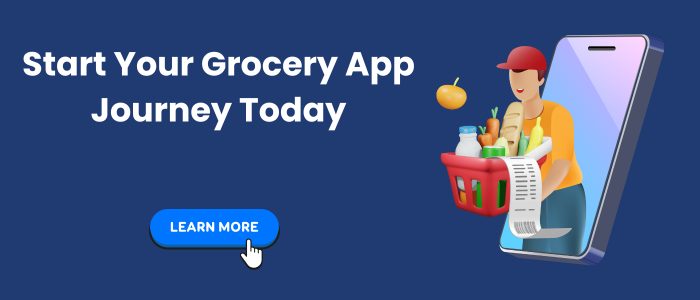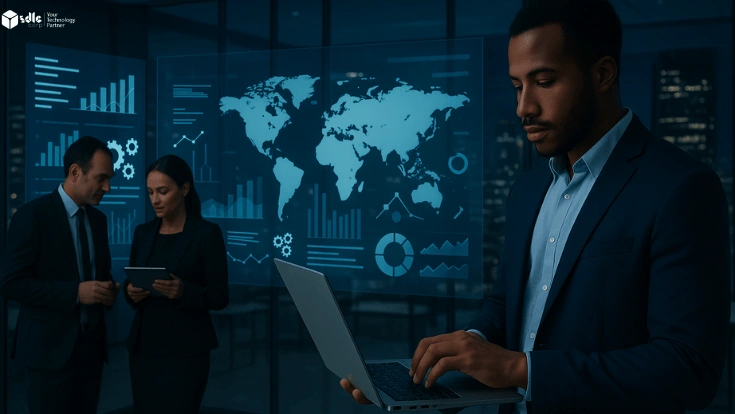In today’s fast-paced world, grocery delivery apps like InstaShop are transforming how people shop. With just a few taps, customers can have groceries delivered to their doorstep efficiently, safely, and on time. If you’re planning to enter this booming sector, building a grocery delivery app like InstaShop is a strategic move.
This blog explores everything you need from features and tech stack to cost estimation and monetization models to create your own on-demand grocery delivery app. Let’s dive in.
How to Build an App Like InstaShop
Creating an app like InstaShop requires a combination of modern technology, financial regulation adherence, and user-centric design. Here’s how the development journey typically unfolds:
- Market Research: Understand the target audience, market trends, and competitor analysis.
- Define Features: List out essential and advanced features based on user needs.
- Choose the Right Technology Stack: Select appropriate frameworks and platforms (iOS, Android, Web).
- Design UI/UX: Create intuitive and engaging user interfaces.
- Develop and Integrate: Code the app and integrate necessary APIs and third-party services.
- Testing: Conduct rigorous testing to ensure functionality and security.
- Deployment: Launch the app on the desired platforms.
- Maintenance and Updates: Regularly update the app to fix bugs and add new features.
Explore Our New Blog – How to Develop App like Blinkit
Grocery Delivery App Features That You Must Include
Creating a successful grocery delivery app like InstaShop requires a robust, user-friendly feature set that supports seamless operations for customers, delivery agents, and administrators. Here’s a deep dive into the essential components:
1. User Features (Customer App)

These features are customer-facing and impact the end-user experience directly. They are designed for convenience, speed, and trust-building.
User Registration & Login (Email, Phone, Social Media) , Allow users to create accounts using their email, mobile number, or social login (Google, Facebook, Apple ID). Offer OTP verification for added security.
2. Product Browsing by Category and Filters

A smooth and intuitive product browsing experience is the backbone of any grocery delivery app. Users should be able to effortlessly explore items organized into clearly defined categories such as:
Fruits & Vegetables
Dairy & Bakery
Snacks & Beverages
Frozen Foods
Personal Care
Household Essentials
Organic & Gluten-Free
Each category should be visually represented with icons or thumbnail images to help users recognize product types instantly. The interface must allow users to drill down into subcategories (e.g., “Fruits” → “Citrus” or “Berries”) for greater specificity.
3. Smart Search Bar with Auto-Suggestions

A smart search bar is one of the most powerful tools to help users find exactly what they’re looking for quickly and efficiently. In a grocery delivery app like InstaShop, this feature is critical to boosting user satisfaction and reducing cart abandonment.
Your search function should go beyond just basic keyword matching. Instead, implement intelligent search algorithms that:
Predict Queries in Real-Time: As users begin typing (e.g., “mil…”), the search bar should suggest complete product names like “milk,” “millet,” or “milk chocolate” based on available inventory.
Auto-Complete & Spelling Corrections: Automatically correct minor typos (e.g., “bnana” → “banana”) and suggest likely product matches using NLP (Natural Language Processing).
Trending & Popular Searches: Display a dropdown list of popular, recent, and trending search terms even before the user starts typing, based on real-time demand and buying behavior.
Category-Specific Results:
Allow users to directly search by categories (e.g., typing “organic” filters only organic items across fruits, snacks, etc.).Voice Search Integration (Optional):
Provide a microphone icon to enable voice queries, especially useful for multitasking users or those with accessibility needs.
4. Cart & Checkout with Multiple Address Options

The cart and checkout experience can make or break the success of your grocery delivery app. A seamless, intuitive, and flexible checkout flow ensures users complete their purchases without frustration or friction.
Allow users to:
Add, remove, or modify item quantities with a single tap
View subtotal, taxes, delivery charges, and savings in real-time
Apply promo codes or loyalty points directly within the cart
Incorporate smart cart suggestions like:
“Frequently bought together”
“Add more to get free delivery”
“You saved ₹X on this order”
5. Real-Time Order Tracking

One of the most essential features in a grocery delivery app like InstaShop is the ability to offer real-time order tracking. It builds transparency, enhances trust, and keeps customers informed throughout the order lifecycle.
Live GPS-Based Tracking
Once an order is placed and accepted by a delivery partner:
Users should be able to track their order status in real-time, from order confirmation to dispatch, en route, and final delivery.
Integrate GPS tracking via Google Maps or Mapbox SDK to show the exact live location of the delivery agent on a map interface.
Display a clear route map with current location, estimated travel time, and distance remaining.
6. Secure Payment Gateway Integration
Support popular and trusted payment gateways like Stripe, Razorpay, PayPal, and local providers. Allow users to pay using:
UPI (Google Pay, PhonePe)
Credit/Debit Cards
Net Banking
Digital Wallets
Ensure all transactions are encrypted and PCI-compliant for maximum security and user trust.
7. Dashboard with Sales Insights
Provide a centralized admin dashboard that displays real-time data on:
Total orders and sales
Delivery success/failure rates
Revenue trends and vendor performance
This helps admins make data-driven decisions and monitor operations at a glance.
8. Order & Delivery Management
Admins should be able to view, assign, edit, or cancel orders easily. Use a drag-and-drop interface or automated dispatch system to manage deliveries efficiently.
This ensures faster order fulfillment and fewer delivery delays.
9. Vendor Onboarding & Approval
Enable local stores to sign up easily by submitting KYC documents. Use auto-approval systems for speed, with manual verification options for added control and compliance.
10. Customer Support & Ticketing

Integrate a ticketing system to manage user complaints and queries across all order stages. Support agents can view, assign, and resolve tickets directly from an organized dashboard.
Track issues by order ID or user
Auto-assign tickets to available agents
Update status (open, in progress, resolved)
This improves response time and ensures better customer satisfaction.
How Much Does It Cost to Develop a Grocery Delivery Platform Like InstaShop?
Developing a shopping app like InstaShop can cost between $20,000 and $100,000+, depending on features, complexity, and location. This includes the full development cycle design, development, testing, and deployment. App development costs vary based on the scope and complexity of the app. Here’s a breakdown:
| Tier | Basic MVP | Mid-Level | Full-Scale |
|---|---|---|---|
| Cost | $20K – $30K | $40K – $60K | $60K – $100K+ |
| Timeline | 4-6 weeks | 10-12 weeks | 20-24 weeks |
| Core Features |
|
|
|
| Compliance | KYC basic (manual) |
|
|
| Integrations | 1 Payment API |
|
|
| Security | Standard encryption | Tokenization |
|
| AI/Analytics | — |
|
|
Explore new blog on – How To Develop Fast and Fresh Food Delivery App Like Grubhub
Ways to Monetize Your Instant Grocery Delivery App
Monetization strategies determine long-term profitability. Here are revenue streams you can explore:
1. Commission-Based Model

This is the primary revenue stream for most grocery delivery apps. In this model, your platform earns a fixed percentage from each successful transaction between customers and grocery vendors.
How it works:
- Set commission slabs (e.g., 10–25%) based on vendor category, order volume, or exclusivity.
- Charge per item sold or per total invoice amount.
- Offer lower commissions to top-performing partners as an incentive.
Advantages:
- Predictable and recurring revenue
- Aligns platform growth with vendor success
2. Technology Stack
Implement tiered subscription plans for both customers and grocery partners.
For Customers:
- Monthly or yearly plans offering
- Unlimited free delivery
- Exclusive discounts
- Early access to promotions
For Vendors:
- Subscription for listing premium products or gaining better visibility
- Benefits include waived commission on first X orders or marketing credits
Example: “InstaShop Plus” for users and “Vendor Prime” for stores.
Advantages:
- Stable, recurring income
- Builds customer and vendor loyalty
3. In-App Advertising

Open up advertising slots within your app for vendors, FMCG brands, or local stores to promote their offerings.
Types of Ads:
- Banner ads on the homepage or product pages
- Sponsored product listings in search results
- Pop-up offers or limited-time promo placements
Revenue Options:
- Cost per click (CPC)
- Cost per thousand impressions (CPM)
- Cost per acquisition (CPA)
Advantages:
- High-profit margins
- Non-intrusive if placed well
4. Featured Listings
Charge grocery stores or brands for top placement in category listings, search results, or home screen carousels.
How it works:
- Create “Featured Store” or “Top Brand” sections.
- Let vendors bid for visibility or pay a fixed monthly fee.
Benefits to Vendors:
- Increased traffic and conversions
- Enhanced brand recognition
Advantages to You:
- Direct and premium revenue
- Boosts vendor engagement
5. Delivery Charges
While many apps offer free delivery as an incentive, charging a small convenience or delivery fee can become a substantial revenue stream, especially in busy metros or peak hours.
Ways to Optimize:
- Charge variable delivery fees based on order value, time slot, or distance
- Offer free delivery on orders above a threshold
- Introduce surge pricing during high demand (like weekends or holidays)
Advantages:
- Enhances cash flow
- Encourages users to upgrade to subscriptions
The Tech Stack You Need for On-Demand Grocery Delivery App Development
Choosing the right tech stack is critical for performance, scalability, and maintenance.

1. Frontend Technologies
React Native (Ideal for cross-platform mobile app development)
2. Backend Technologies
Python (Powerful for handling business logic and API integrations)
3. Database Options
MongoDB
PostgreSQL (Support for both structured and flexible data storage)
4. Payment Gateways & APIs
Stripe
Razorpay
Tabby API (Facilitate seamless checkout and split payments)
5. KYC/AML Verification Tools
Onfido
ShuftiPro (Used for automated identity checks and compliance requirements)
Future Trends in Grocery Delivery App Development
To stay competitive in grocery delivery app development, consider integrating the latest tech.
Trends to Adopt
- AI Chatbots for real-time customer support
- Voice Ordering via Alexa, Google Assistant
- Drone-Based Delivery (Pilot testing)
- Dark Stores & Micro Warehouses for hyperlocal delivery
- Blockchain for Inventory Audits
Conclusion
Building a grocery delivery app like InstaShop requires in-depth planning, technical proficiency, and strong UX principles. Whether you’re a startup or an enterprise, leveraging the right features, tech stack, and business models will set you apart in this competitive market.
Looking to launch your own InstaShop-like app?
Talk to our experts at SDLC Corp and take your first step toward building a market-dominating eCommerce app.
Also Read Our New Blogs On.
How To Develop Delivery App Like INSTACART?
How to Develop App like Zepto
Cost to Build an App Like Jahez: Complete Estimation Guide
Why Choose SDLC CORP for Grocery App Development?
At SDLC Corp, we specialize in building custom grocery apps tailored for security, scale, and success.
Here’s what sets us apart
- Experience: 20+ Delivery App solutions across the globe
- Security-first approach: PCI DSS, GDPR, PSD2 compliance
- Custom UI/UX: Engaging, intuitive designs
- DevOps & Post-launch Support: CI/CD pipelines, 24/7 monitoring
- Agile Delivery: Rapid MVP to scale journey
Whether you’re a startup or scaling enterprise, we help you design, develop, and grow a app like Instashop with the perfect balance of performance and budget.
Explore SDLC CORP top notch services:
Mobile App Development Services
FAQ'S
What Tech Stack Is Best for Grocery Delivery App Development?
The ideal tech stack includes Flutter or React Native for mobile, Node.js or Python for backend, and MongoDB or PostgreSQL for the database.
How Long Does It Take to Develop an InstaShop-Like App?
Depending on features and complexity, development can take 4 to 6 weeks for an MVP and up to 20 to 24 weeks for a full-featured app.
How Do You Implement Real-Time Order Tracking in a Grocery App?
Real-time tracking is built using GPS APIs like Google Maps or Mapbox, combined with WebSocket-based communication for live updates.
Can the App Handle High User Loads and Peak-Time Traffic?
Yes, using cloud infrastructure (AWS, GCP) with auto-scaling and microservices architecture ensures scalability and reliability.
How Much Does It Cost to Build a Grocery Delivery App Like InstaShop?
The cost typically ranges between $20,000 to $100,000, depending on location, features, and development model (in-house vs outsourced).
What Are the Key Features Required in a Grocery Delivery App?
Must-have features include product browsing, smart search, real-time tracking, multiple payment options, and user ratings.
How Can I Monetize My Grocery Delivery App?
Common monetization models include commission on sales, in-app advertising, subscription plans, and featured vendor listings.
Is It Necessary to Launch with All Features at Once?
No, it’s recommended to launch an MVP (Minimum Viable Product) with core features and gradually scale based on user feedback and performance.






